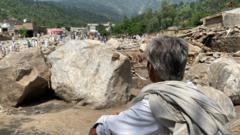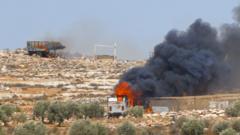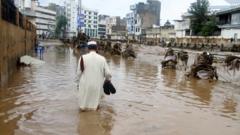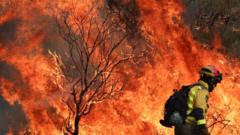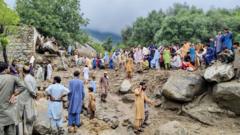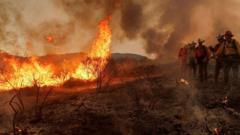In the wake of catastrophic monsoon floods and landslides that have impacted northwest Pakistan, authorities report more than 200 individuals missing, highlighting the grim reality of a disaster exacerbated by climate change.
Devastating Monsoon Floods Leave Over 200 Missing in Northwest Pakistan
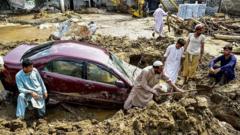
Devastating Monsoon Floods Leave Over 200 Missing in Northwest Pakistan
A tragic aftermath of monsoon flooding in Pakistan sees over 200 individuals unaccounted for as floodwaters wreak havoc across the region.
More than 200 individuals are currently unaccounted for in the Buner district of north-west Pakistan following a series of devastating monsoon floods and landslides, according to local officials. The torrential rains have claimed at least 300 lives across Pakistan and Pakistan-administered Kashmir in recent days, with a significant number of fatalities occurring in the Khyber Pakhtunkhwa province, where Buner is located.
Jehangir Khan, a spokesperson from the deputy commissioner’s office in Buner, indicated that at least 209 people remain missing, and the toll may continue to rise. Rescue teams have buried eight unidentified bodies due to the absence of family members able to come forward, with severely damaged roads hampering access. Reports suggest that up to "10 to 12 entire villages" have been compromised, adding to the local tragedy.
Asfandyar Khattak, head of the provincial disaster management authority, confirmed that many individuals from the neighboring Shangla district are also missing. The monsoon rains, which typically occur between June and September and account for about 75% of South Asia’s annual precipitation, have intensified due to climate change, creating more frequent and severe weather events, including landslides and flash floods.
In addition to the devastations in Pakistan, Indian-administered Kashmir has experienced similar conditions, with at least 60 fatalities reported from flash floods in recent days. The current toll includes nine deaths in Pakistan-administered Kashmir and five in the Gilgit-Baltistan region as authorities brace for continued heavy rainfall expected until August 21, with several districts declared disaster zones.
Pakistan is facing the impact of this year's monsoon season, which began in June and has taken at least 650 lives to date. Notably, Punjab, which houses nearly half of Pakistan's 255 million population, reported a staggering 73% increase in rainfall compared to the previous year, resulting in more fatalities than recorded in the prior monsoon season.
The northern region of Pakistan, known for its vast glacier coverage, is witnessing accelerated glacial melt attributed to climate change, leading to destabilization of mountainous terrains. Flash floods and landslides can block rivers, creating further dangers for communities. While the precise causes of the recent disasters are under investigation, glaciologists acknowledge that ice melt is a contributing factor. The current crisis underscores the urgent need to address the intertwining challenges of climate change and natural disasters in vulnerable regions.

